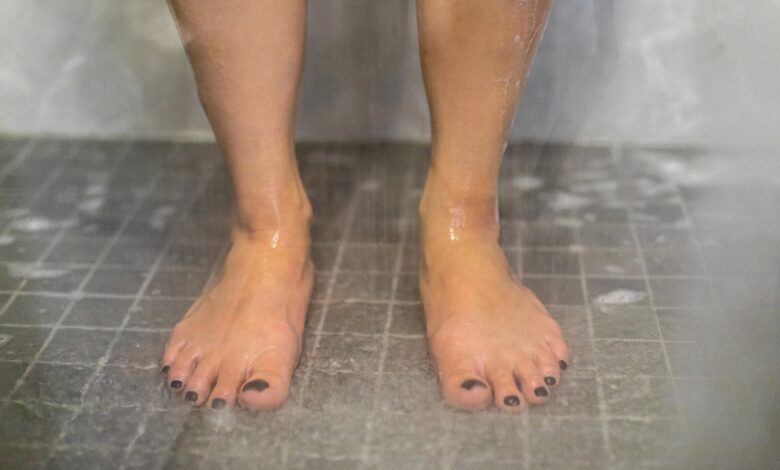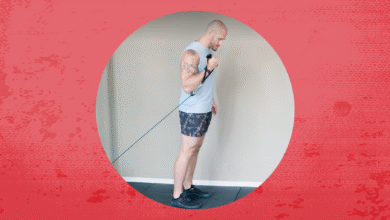Why Peeing in the Shower Is So Bad for Your Pelvic Floor

All products are independently selected by our editors. If you buy something, we may earn an affiliate commission.
Let’s be real: Peeing in the shower can be a pretty convenient way to empty your bladder. Not only are you saving a minute or two on the toilet (time is precious, y’all), but a case could be made that it’s better for the planet because you’re reducing your toilet paper and water usage overall. (No flushing necessary!) At this point you’re either nodding in agreement or wincing in disgust, thinking, Who does this? Turns out, lots of people. In fact, one YouGov poll found that 62% of Americans—both men and women equally—have peed in the shower at some point and 21% do it all the time.
However, there’s one thing you might not have thought about: Research suggests the practice might be hurting your pelvic floor over time, which isn’t really great for your urinary health. (Your pelvic floor includes the muscles between your tailbone and pubic bone that support your urethra, bowel, rectum, anus, and, yup, you guessed it, your bladder.) “You pee every day and don’t really think about it as long as it’s all going well,” Leslie Rickey, MD, MPH, a urogynecologist and associate professor at the Yale School of Medicine, tells SELF. “It’s only when things start to not go well that you think, Oh, what could I have done differently?”
Whether you’re a pee-in-the-shower type of person (or even tend to hover or squat above the seat when using public toilets), here’s what to know about how these non-sitting positions can affect your pelvic floor.
First, let’s talk about how your bladder and pelvic floor work together.
No matter what you’re doing, your bladder and pelvic floor are generally in sync. “When one is on, the other should be off,” Alicia Jeffrey-Thomas, PT, DPT, a pelvic floor physical therapist at MomLife Health & Wellness in Massachusetts and author of the forthcoming book Power to the Pelvis, tells SELF. Basically, when your bladder is filling up during the day, your pelvic floor muscles are contracted to “keep the doors closed” and prevent urine from slipping out, Dr. Jeffrey-Thomas says. This is why a lot of people can do a squat at the gym, sneeze, or anything really without leaking. When you pee, the roles reverse; your bladder contracts and your pelvic floor relaxes to allow a smooth stream to exit.
But when you’re peeing in the shower or squatting over a toilet, your pelvic floor can’t relax like it normally does when you’re sitting down. “So what’s happening then is you’re having to basically push a little bit, whether subconsciously or consciously, to bypass that mechanism that’s trying to keep things closed in that standing position,” Dr. Jeffrey-Thomas says, “and that pushing is not great for your pelvic floor.” (If you are a person with a penis, you generally don’t have this issue because your prostate sits under the bladder and supports it; also, standing to pee is generally your standard operating procedure.)
Why you shouldn’t pee in the shower (or hover over the toilet).
Just like your muscles may get tired after working too hard, your pelvic floor can become less effective if it’s constantly doing too much, Dr. Jeffrey-Thomas says. Over time, this can lead to some pelvic floor dysfunction that includes a general weakening of the muscles in that area, as well as incontinence (when pee occasionally leaks out) or an overactive bladder, Dr. Rickey says, which can leave you with that uncomfortable I gotta go right now sensation.
Peeing in the shower regularly can also create a funky association between the sound of running water and urinating, which is inconvenient, to say the least. “I probably hear that at least once a week. I’m not kidding!” Dr. Rickey says. “There’s something about the external environment that gets cross-wired with the urinary reflex that starts in your brain…. It makes you feel that urge to go.”
There’s really no telling how many times you’d have to pee in a shower to notice pelvic floor issues. But considering that most of us shower every day, it may be worth ditching this habit if it’s something you do pretty regularly. “Could be years, could be decades, but you are using your bladder over your lifetime,” Dr. Rickey says, “so there’s a long time for your practices to affect its function.”
There are certain conditions and life events that can cause bladder dysfunction on their own, so mixing that with a lifetime of shower pees and toilet squats can get complicated. For example, chronic constipation, diabetes, childbirth, and menopause can do a number on your pelvic floor, experts tell SELF. “It might just be that one of these things maybe doesn’t greatly increase your risk,” Dr. Rickey says, “but when you put them all together in the right environment, then that sets up a situation where [you can] actually develop bladder issues.”
How to keep your pelvic floor strong—and when to see a specialist.
Luckily, this problem has a simple fix—avoid standing or hovering while you pee, and sit down as much as you can, Dr. Jeffrey-Thomas says: “It’s kind of one of those ‘an ounce of prevention is worth a pound of cure’” situations, because “you can’t just Kegel your way out of bad bladder habits.” Showers are convenient and public toilets can seem gross, but your pelvic floor will thank you for taking the extra minute to actually sit down. (And in case you’re wondering: No, you can’t really catch anything from sitting on a toilet seat.)
In the meantime, exercises like yoga and Pilates can boost your bodily awareness and keep your pelvic floor strong. But any workout, really, can do the trick, Dr. Jeffrey-Thomas says, so long as you engage these muscles properly. She likes to describe the process as a “squeeze and a lift” and offers a helpful analogy: Imagine that there’s a blueberry sitting in your underwear and you want to scoop it up with your vagina. “It’s a very small movement,” Dr. Jeffrey-Thomas says. “It’s not incorporating your abs, glutes, or inner thighs. You’re not holding your breath.”
If you’re experiencing pain, frequent urine leaks, or an urgent need to pee when your bladder isn’t really full, then you should see a pelvic floor specialist to be evaluated, Dr. Rickey says. Although an expert can’t necessarily confirm that your pee habits are to blame, they can prescribe meds to relax your bladder muscles or refer you to a pelvic floor therapist depending on what’s going on. “A lot of women have bladder issues and think they’re the only ones” Dr. Rickey says. But remember that you’re not alone, and it’s more than okay to ask for help.
Related:
- How to Stop Waking Up to Pee at Night So You Can Get Better Sleep
- 7 Symptoms of a Tight Pelvic Floor, From Painful Sex to Constipation
- Is It Bad That I Can’t Pee in a Steady Stream?
Get more of SELF’s great service journalism delivered right to your inbox.



